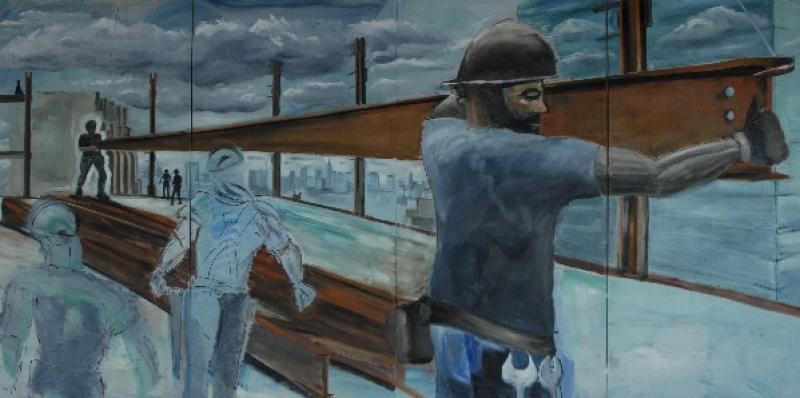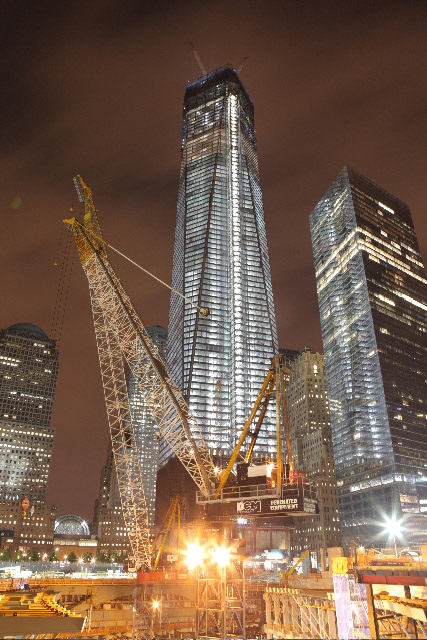Rebuilding the World Trade Center, Channel 4 | reviews, news & interviews
Rebuilding the World Trade Center, Channel 4
Rebuilding the World Trade Center, Channel 4
An artist's view of how the WTC is returning to New York's skyline

“I see a lot of things up there, I get chills, see shadows. I don’t know if you call them ghosts or whatever, but you feel stuff. They’re trying to tell you something.” This is bolt boss Mohawk Joe “Flo” McComber, one of the many Mohawk iron workers rebuilding the World Trade Center. A tough guy, he’s not alone in sensing the spirits of the dead. “The site is being take care of in a different way. You feel it,” says Mike O’Reilly, another ironworker.
Belfast-born artist and film-maker Marcus Robinson has been on site since 2006, recording the rise of 1 WTC from bedrock upwards with time-lapse filming – speeded-up cranes at work are an amazing sight – as well as painting the process. Rebuilding the World Trade Center isn’t just the documentation of the tallest building in NYC though, but a homage to the world of its construction workers who work so high up that they can almost “see the earth’s curve”. They’re above the endless nasty skirmishes that surrounded Ground Zero politics. 1 WTC, probably at $3.9 billion the most expensive office tower ever, has had two different architects and three different designs. No wonder the opening’s been delayed.
Filming those ironworkers when they’re connecting girders 1,776 feet up requires nerves of steel, with or without ghosts. “It’s dangerous up there,” says raising gang foreman Gary Best, master of understatement. Robinson must have developed an unusual head for heights as well as a hard-won rapport with the guys, many of whom work seven days a week, 10 hours a day for four-week stretches. “You have to give yourself up to get the job done,” says one.
 Ironwork is a legacy profession. The Mohawks of Quebec have been doing it ever since the 1880s. “Never turn your back to a crane,” McComber remembers his father telling him. And Mike O’Reilly, a connector whose father was paralysed after a fall when working on the original World Trade Center, decided to enter the family profession after 9/11 (his parents had previously been against it because of his dad’s accident). When the towers still stood, his father felt that at least he got hurt for something. Now there was nothing. He was devastated and Mike was determined to help. His father made a few calls and got him into the union. “It’s beautiful to see people continuing a tradition laid down by their forefathers,” says Robinson, and the respect shown to fathers and great-grandfathers in these interviews is extraordinary.
Ironwork is a legacy profession. The Mohawks of Quebec have been doing it ever since the 1880s. “Never turn your back to a crane,” McComber remembers his father telling him. And Mike O’Reilly, a connector whose father was paralysed after a fall when working on the original World Trade Center, decided to enter the family profession after 9/11 (his parents had previously been against it because of his dad’s accident). When the towers still stood, his father felt that at least he got hurt for something. Now there was nothing. He was devastated and Mike was determined to help. His father made a few calls and got him into the union. “It’s beautiful to see people continuing a tradition laid down by their forefathers,” says Robinson, and the respect shown to fathers and great-grandfathers in these interviews is extraordinary.
The combination of time-lapse photography – Robinson had 13 cameras on the go, taking one frame every 30 minutes, and likens it to a meditation – with the workers’ testimonies is very effective, though some of them, such as Mike O’Reilly and his partner Tommy Hickey (ironworkers always work in pairs), I’d seen before in the Spielberg-produced six-hour documentary Rising, shown on the Discovery channel in August 2011. I wondered if Tommy and co get fed up with film-makers constantly shadowing them. Mightn’t it add to the pressure? Or maybe they enjoy telling the world what the building means to them. They certainly seem to, even Keith Brown, who looks like he could take on Big Pussy from The Sopranos. He gets into work at 4am because he doesn’t want things to get behind schedule and lets rip for the camera with a string of full-bodied curses.
And, surprisingly, they’re not all men. There’s surveyor Karen Mulligan, whose father worked on the twin towers as an operating engineer. Chantelle Campbell was a secretary before she got bored – the only good part of her admin job was “looking nice” – and became a concrete carpenter. A lot of female carpenters, she says, are happy doing light work and fetching coffee, but not her. “I want to be seen on the same level as the men… I don’t have the type of personality where I’m going to back down. That gets me a lot of respect.” You believe her.
I lived near Ground Zero during Robinson’s tenure and passed 1 WTC almost every day. It was an impenetrable fortress, hidden behind fencing and turnstiles: it felt cut off from the rest of life downtown, so Robinson’s affecting film goes some way towards uncovering its mystery before it opens for business in 2015.
The future of Arts Journalism
You can stop theartsdesk.com closing!
We urgently need financing to survive. Our fundraising drive has thus far raised £49,000 but we need to reach £100,000 or we will be forced to close. Please contribute here: https://gofund.me/c3f6033d
And if you can forward this information to anyone who might assist, we’d be grateful.

Subscribe to theartsdesk.com
Thank you for continuing to read our work on theartsdesk.com. For unlimited access to every article in its entirety, including our archive of more than 15,000 pieces, we're asking for £5 per month or £40 per year. We feel it's a very good deal, and hope you do too.
To take a subscription now simply click here.
And if you're looking for that extra gift for a friend or family member, why not treat them to a theartsdesk.com gift subscription?

Add comment